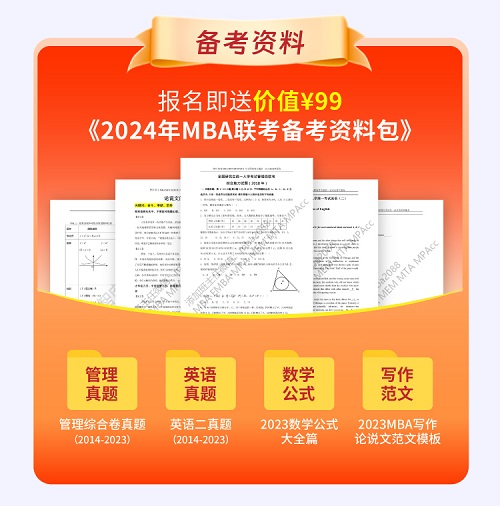MBA考试英语阅读应试技巧与策略
2013年08月19日18:02 智库商学院 阅读量:
一、阅读应试的基本方法步骤
阅读基本方法有3种,一是略读,二是精读(scrutinizing),三是寻读。略读是一种快速阅读方法,在非常短的时间内浏览全文获得文章的中心思想和主要事实。精读则是仔细阅读每句话,理解分析其含义,弄清句与句之间的逻辑关系,进而理解整个段落的意思。而寻读则是通过目光扫视,迅速确定你所期望得到的信息的位置。考试中3种基本方法可以用在不同的情况。通过略读,我们可以了解材料的结构安排和主要信息,利用精读我们可以针对考题中的某些信息或难点做具体细致的解析,而寻读则在解题过程中起着一个定位的作用。 不少考生常常提出这样一个问题:做阅读理解题是先读文章还是先读后面的问题呢?我们认为,答案因人而异。英语水平较高,阅读速度较快的考生可以先通读短文,一边阅读一边思考文章的主旨大意, 理解文章的细节, 基本理解原文之后再看考题及选项并做出选择,遇上个别无把握的题时再回头查阅短文的相关部分,仔细推敲定夺,以求准确无误得高分。但这种方法只适合那些有能力获取优异成绩的考生,其优点是对文章有一个总的概念和印象,缺点是,费时间,对文章的细节记不清楚。对于大多数考生来说,考试的时间较为紧迫,我们 建议使用以下几个步骤:
第一步:略读短文 把握方向
用尽量短的时间扫视短文,特别留意每段的第一句和最后一段的最后一句。因为各段的主题句往往在句首,而文章的最后一句很可能是概括总结。略读的目的是掌握短文的主旨大意,做到对全文的内容心中大致有数,有一个思考的方向。
第二步:浏览问题,有的放矢
浏览5个问题,揣测出题者出此题的目的并侧重阅读短文相关部分。由于对所问问题及文章主旨都已有所了解,在阅读时自然会知道哪些地方得细读哪些地方可一带而过甚至跳过不读。所有问题都是根据文章内容提出的,基本反应并覆盖了文章内容的主干。先阅读问题再阅读全文,这种方法的优点是:可在较短的时间内有针对性地阅读相关内容,便于给相关问题定位,有的放矢,事半功倍。
第三步:分析判断 确定答案
在完成上面两步的基础上,对5个问题逐一解答。需要注意的是:要是文章内容涉及你所熟悉的题材和知识范畴,在选项时绝对不能单凭自己的主观判断解决问题。因为文章考的是你对该篇的阅读理解能力,而不是你的某种知识,因此选项不能脱离文章的题意。 对于英语水平相对较低,阅读速度较慢的考生来说,我们建议不妨直接从第二步开始:先浏览所有5道题的题目,对文章所涉及的内容有个粗略的估计或了解,然后逐一解答。先寻读文章的相关部分,然后选择正确答案。如遇到有关文章主旨大意或需要推理的题,可先放一放,等做完其他题再做这类题。先难后易,各个击破。 另外,在阅读过程中,不妨在自己认为比较重要的某些句子或词语(主题句,关键词)下面划线,标上符号,这样有助于突出重点,活跃思维,同时也便于阅读,节省时间,使阅读更加积极。并且对于记忆力稍差的考生而言,记住几个重要句子和信息要比记住全文容易得多了。所以,我们建议对阅读文章中的主要句子和关键词标出记号并重点阅读。
二、阅读考试中碰到不认识的生词怎么办?
考生最害怕在阅读中碰到生词,而在阅读时,遇到生僻的单词是不可避免的。如果一见到生词就不知所措,就必然会影响到对文章的理解。如果遇到这种情况,可以根据情况用不同的方法来解决问题。要是不认识的生词对理解文章的关系不大,就可以跳过去不管它。譬如这样一例:Some birds can swim on the water. A few, like the penguin and puffin, can also swim under water. 我们只需知道penguin 和puffin是两种鸟就行了,不必将它们的具体名称弄个一清二楚。 阅读中经常会遇到一些专有名词(包括人名、地名、组织机构名称等),一般都可以不作计较,必要的时候,用X、Y的字母代替它们就行了。以2003年阅读Text 4为例,文章出现了若干复杂的人名、职务名:Colorado governor Richard Lamm, Viacom chairman Sumner Redstone, Supreme Court Justice Sandra Day O'Connor, C. Everett Koop,而且后面的提问与其中的一个人有关,我们分别记为Mr. L, Mr. R, Mr. O, Mr. K 即可,这样便省去了不必要的纠缠。 当然,如果遇到的生词影响到了你对文章的理解,特别是作为考点出现在问题里,就要试着根据上下文、构词法或从句中认识的词中去猜测生词的意思,尽可能通过邻近你所熟悉的词的关系来了解该词在句中的作用和词义。如2003年阅读Part B 中的"Anthropology"一词,要求翻译出来。虽说超纲了,但根据构词法和上下文其含义已经解释得十分清楚:"Anthropology" derives from the Greek words anthropos "human" and logos "the study of." 由此我们得知 "Anthropology"一词源于希腊词语anthropos(人类)和 logos(…研究)。要是还没有把握,再多看一句就更万无一失了:By its very name, anthropology encompasses the study of all humankind.(用这一名称,“人类学”包括了对整个人类的研究。)
三、如何猜测不认识的词语?
在阅读文章的过程中,考生面临最大的问题是遇到不认识的单词或短语,或者认识的单词在文章中有了新的含义。如果这些词或短语不影响对文章主要内容的理解,考生便可以将它们略过,不中断阅读。如果这些词语的意思对正确理解文章很重要,就必须根据上下文的联系,根据构词法或其他方法对它们的意义进行猜测,使之不影响对整篇文章的理解。猜测词义通常可采用以下几种方法。
1. 利用上下文确定词义
通过上下文来猜测词意是阅读考试中最常用的重要手段之一,联系上下文可以帮助我们理解句子,确定词义。下面我们通过一些实例来简要说明如何通过上下文来确定词义。
- 例1:He is successful as a businessman because of his dynamic personality. He seems to have unlimited energy.
- 对于dynamic一词大家可能不熟悉,下文的He seems to have unlimited energy…(他似乎有用不完的劲)就是对 dynamic词义的解释。这样,我们便知道该词意为“有干劲的”。
- 例2:Sociology is the term used to describe the scientific study of human society.
- 假定sociology是一个不认识的词,系动词be后面就给出了明确的定义。这样,我们便知道该词意思为“社会学”。
- 例3:A first-year college or university student is commonly a 'freshman', and ‘sophomore’, 'junior’ and 'senior' des¬ignate the second—third—and fourth—year student.
- 要是对sophomore, junior 和senior几个术语不熟悉,通过后面的对应解释词语the second—third—and fourth—year student我们便不难知道它们分别是指二、三、四年级的大学生。
- 例4:The tired soldiers trudged through knee-deep mud for hours before they found a dry place to sleep.
- 通过后面的through knee-deep mud(没膝深的泥浆),我们知道trudged一词的意思为与行走这一动作有关,在泥浆中行走,也就是“跋涉”。
- 例5:When it comes to manufactured goods there is actually more diversity in this country than Europe has ever known. The variety of goods carried by our stores is the first thing that impresses any visitor from abroad.
- 第二句中的variety与第一句中的diversity 同义,这样,我们便不难知道diversity的大意是“种类”或“品种”。
下面我们联系上下文,试确定以下各句中斜体字的含义。
- 1. The woman and the children were skilful in boats too, but there were usually several of them in a large boat called umiak.
- 2. The doctor said that if a person ate even one leaf of the hemlock plant, he would die, because the plant is a deadly poison.
- 3. Although dogs and cats often have large families, rabbits are famous for the size of their litters, which sometimes number more than twelve bunnies at one time.
- 4. Mark became hysterical when his basketball team won, and he did not calm down for several days.
- 5. With mud from head to toe, flowers still clutched in his hand, John looked so ludicrous that we couldn’t help laughing.
- 6. A bee collects nectar not in its own stomach but in a kind of shopping bag (called the honey sac) similar to the one ants have.
- 7. Several generations ago, the world seemed to run in an or¬derly way. Now, however, everything is in a state of tur¬moil.
- 8. After the first time someone tried to rob him, the banker be¬came flustered easily, and in his confusion he would make many careless errors.
- 9. Jane was intrigued by the behavior of animals; she could sit for hours observing a bird making a nest or an ant carrying a leaf.
- 10. Some chimps are very independent and appear to be the superior members of a group; others seem to be ruled by the leaders and are quite submissive.
通过上串下联,我们不难确定上述各句中斜体字的含义如下: 1. umiak n. 一种大船 2. hemlock n. 一种有毒植物(毒芹) 3. litter n.一窝 bunnies小兔子 4. hysterical a.歇斯底里,异常兴奋 5. ludicrous a..滑稽可笑的 6. nectar n.花蜜 honey sac蜜胃 7. tur¬moil n.混乱 8. flustered a.慌乱的 9. intrigued a.感兴趣 10. submissive a.顺从的
2. 利用构词法确定词义
通过观察构词部分,分析辨认单词,是提高阅读速度的技巧之一。一方面,读者不必停下来查词典,继续往下读;另一方面,也大大增加了读者的词汇量,读者通过已知词缀(包括前缀和后缀)和已知词根就能很好地猜出生词的含义。
- 例1:Many cancers have been arrested with the use of chemotherapy.
- Chemotherapy 是由chemo(意为chemical)和therapy (意为treatment),整个单词意思就是“化学疗法”。
- 例2:They overestimate the interviewee’s ability and asked turn many difficult questions.
- overestimate =over (过分、过度)+estimate (估计)。因此overestimate的词义可猜测为“过高估计”。
- 例3:The murderer had developed a poison which could not be tasted or smelled when mixed with food. Because it was imperceptible, he was able to murder a number of people without being caught.
- 句中的imperceptible 一词由前缀im-(非,不)+词根percept(感知、觉察)+后缀 -ible(能……的)构成。几部分组合在一起,也就是“难以觉察的”之意。
- 例4:Social science is that branch of intellectual enquiry which seeks to study humans and their endeavors in the same reasoned, orderly, systematic, and *dispassioned manner that natural scientists use for the study of natural phenomena. (2003考研英语第62题)
- 其中的dispassioned为超纲词,我们可根据构词法dis + passion + ed知其大概意思:除掉激情的,也即是“冷静的”。
3. 利用语法知识确定词义
在很多情况下,各种语法知识可以帮助我们来判断词性、词义。
- 例1:This set of books is for children. The first book of the sequence, which is one of the most popular series of children’s stories, is a group of stories about the inhabitants of a village.
- 假定我们不认识sequence,利用定语从句which is one of the most popular series of children’s stories, 其中series就与sequence 同义,也就是“丛书”的意思。
- 例2:For their fishing and hunting the men used a kayak, a small boat for one person.
- 利用同位语a small boat for one person我们知道kayak是一种单人小船。
- 例3:A solar eclipse—when the moon passes between the Earth and the sun—in an unusual and interesting phenomenon that occurs rarely.
- 通过破折号解释我们知道solar eclipse为“日食”。
- 例4:Ventilation, as we know, is a system or means of provid¬ing fresh air. It plays a very important part in the field of engineering.
- 通过后面的解释我们知道Ventilation为“通风,流通空气”之意。
- 例5:The modern age of medicine began with the stethoscope, an instrument for listening to a patient’s heartbeat and breathing.
- Stethoscope一词大家都不熟悉,通过后面的同位语解释an instrument for listening to a patient’s heartbeat and breathing,我们便能理解stethoscope的确切词义,即“听诊器”或“听筒”的意思。
4. 根据同义、反义关系确定词义
阅读中,特别是要注意表示反意的信号词:in contrast, on the other hand, rather than, however, yet, although, while, unlike, but, whereas, as opposed to等,利用这些同义、反义关系,可以帮助我们确定词义。
- 例1:My sister Mane is an optimist, while her boyfriend is one who is always gloomy and expects the worst to happen.
- 从while的转折关系可知optimist意思是“one who expects the best’’, 即“乐观的”。
- 例2:Mother was tall, fat, and middle aged. The principal of the school was an older woman, almost as plump as Mother, and much shorter.
- 根据Mother was tall, fat 以及后面as plump as的同义关系,我们知道plump为“丰满的”之意。
- 例3:Sally liked to concoct all sorts of stories, but her mother always knew when she was lying.
- concoct一词大家不熟悉,根据but的转折关系我们知道在此句中与was lying的含义大体相同,由此可知concoct的大概意思是“编造谎话”。
- 例4:A gorilla always makes me think of the word aloof—not friendly, of distance from others.
- 假定我们不认识aloof一词,破折号后的反义关系:“不友好,冷漠” 就解释了aloof一词的含义。
5. 利用逻辑推理和常识确定词义
有时候,逻辑推理和自身的生活经验及普通常识能帮助我们确定词义。
- 例1:Fishes live in water and have fins which help them to swim. Most fishes have slimy skins covered with scales, but in fishes such as eels the scales are very small and can hardly be seen.
- 凭常识我们不难猜出fins, slimy和scales的确切意思分别是“鳍”、“滑溜的”和“鳞”,对于eels一词,我们只需知道是fish的一种(鳝鱼类)就行了。
- 例2:Not wanting to disturb the sleeping kitten, I gingerly lifted her from the box and put her on a blanket near the heater.
- 根据前半句的Not wanting to disturb(不愿打扰),我们便可大致推测出gingerly一词的含义:“小心翼翼地”。
- 例3:A mercury thermometer is made of a glass tube with a bulb at one end.
- 凭常识我们知道温度计下面的bulb是“水银球”。
- 例4:Most troubles can be avoided, but death and taxes are in¬evitable.
- 凭常识我们知道死亡和税收是不可避免的(in¬evitable)事情。
17年考辅名师倾情指导,带你入门MBA联考备考
点击立即报名 ![]() :https://ke.mbalib.com/pc/column/939?cid=1%3Ffrom_source%3Dsxylb
:https://ke.mbalib.com/pc/column/939?cid=1%3Ffrom_source%3Dsxylb
详细课程咨询添加微信:mba2088


